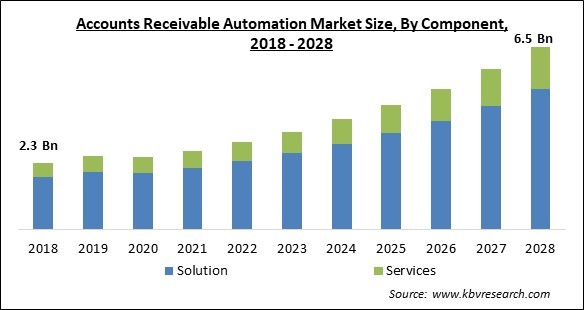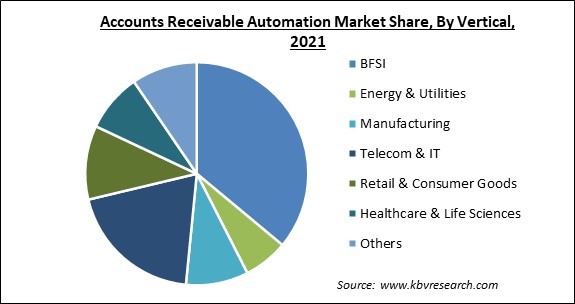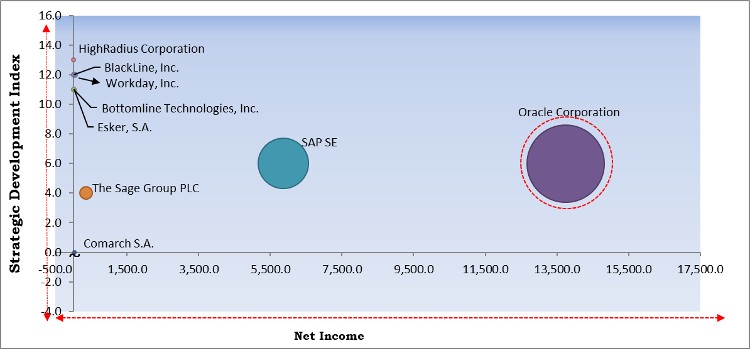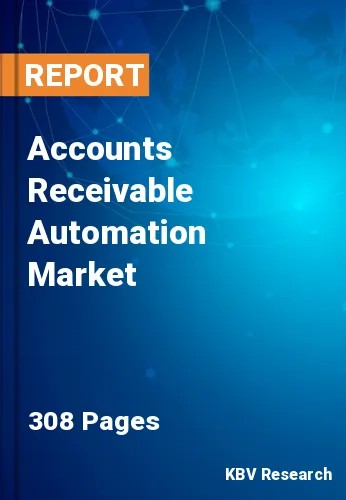The Global Accounts Receivable Automation Market size is expected to reach $6.5 billion by 2028, rising at a market growth of 13.1% CAGR during the forecast period.
Accounts Receivable (A/R) automation software is a solution that uses Artificial Intelligence and Robotic Process Automation in order to update accounts receivable processes and decrease repetitive and time-consuming procedures. Instead of keying in remittance data, printing paperwork, and downloading backup documentation, A/R Automation allows more time for A/R teams to focus on higher-value activities, such as minimizing daily sales outstanding and monitoring high-risk accounts to prevent bad debt.

It can also assist businesses in increasing the likelihood of rapidly approved invoices being paid by the clients. It allows users to save time and avoid common invoice errors, the majority of which are caused by human error or a lack of understanding of the customer’s invoicing requirements. Switching to and reaping the benefits of e-invoicing provides certain automation benefits. Customers may have special distribution criteria or purchase referrals to help them validate the invoice, in addition to examining items for accuracy, pricing, and company information. Any errors in this process can result in delayed payment, credited bills, and other inconvenient and time-consuming difficulties.
The AR staff may focus on addressing delinquent payments or projecting cash flow by minimizing the time invested on each invoice and making the overall workflow more efficient. In other words, by relieving employees of the most time-consuming activities, they may focus on ensuring the company’s success. E-invoicing is becoming legislated in an increasing number of nations, with systems using it. It rapidly becomes complicated, especially if the company has customers in multiple marketplaces because each country has different standards. In these situations, various AR Automation solutions can assist organizations in adhering to local regulations. It also allows businesses to get paid across markets and gives them a single point of contact for all of the global invoicing.
The COVID-19 pandemic landed a significant impact on several businesses all over the world. Various businesses across the world were shattered due to the imposition of lockdown worldwide. Due to the lockdown scenario, manufacturing facilities of numerous companies were shut down, due to which, there was a significant demand-supply gap. Additionally, the global supply chain was also devastated as a result of the pandemic. Moreover, the pandemic's impact on the accounts receivable automation market has benefited both large and small businesses in a variety of industries. Accounts receivable automation provides a solution to the pandemic's issues.
Late payments and unforeseen expenses can drive an organization into disarray and make it difficult to recover. Without having to annoy the clients for prompt payment, accounts receivable automation financing helps businesses to transform credit sales and invoices into cash immediately. In addition, accounts receivable automation advances the entire amount of the invoice without impacting relationships with the client relationships. While traditional accounts receivable approaches make the user wait for bills, accounts receivable automation can cover expenses including payroll and rent.
In the conventional accounts receivable approach, the risk of human errors was substantially higher due to manual processing. Moreover, it was costlier due to several factors, like the dedicated staff. Service quality suffers as a result of plugging errors, matching problems, and missing or misfiled papers, which can bother vendors and exasperate business managers. By extracting and entering data, AR automation can help eliminate errors. When compared to human data entry, business process automation reduces the quantity of data errors when it comes to supplier names, invoice dates, check numbers, invoice amounts, PO numbers, and individual line items ordered.
Asynchronous workflows are another issue with typical accounts receivable operations. Traditional accounts receivable operations are isolated, which means that data is not automatically shared between systems, necessitating manual consolidation. Asynchronous systems may result in missing insights and trends, limiting the ability to keep a pulse on overall receivables functionality at a glance. The capacity to update the business accounts receivable department may be hampered by asynchronous processes and technology. Companies can have problems introducing new solutions without a big rework if current systems are not interoperable. These systems may function adequately in the organization's current state, but they can collapse as volume increases.

By the Component, the Accounts Receivable Automation Market is bifurcated into Solutions and Services (Managed Services and Professional Services). In 2021, the solution segment acquired the largest revenue share of the accounts receivable automation market. The rapidly rising growth of this segment of the market is majorly attributed to increasing demand for accounts receivable solutions in the BFSI sector all over the world. BFSI sector is one of the largest applications of the accounts receivable solutions. In addition, the employment of these services is also surging in various businesses due to attributes, such as Calculate the average balance. Add up the beginning and ending receivables from a designated period, calculating net annual credit sales, and dividing the net annual credit sales with the average account receivables.
On the basis of Vertical, Accounts Receivable Automation Market is segregated into BFSI, IT & Telecom, Manufacturing, Consumer Goods & Retail, Healthcare, Energy & Utilities, and Others. In 2021, the consumer goods and retail segment witnessed a significant revenue share of the accounts receivable automation market. The increasing growth of the segment is owing to the constantly growing consumer electronics sector all over the world. The complete payment collection procedure from customers in exchange for items purchased is referred to accounts receivables within the consumer goods and retail vertical. Accounts receivable automation systems are being adopted by retailers for a variety of reasons, including lower business time, higher revenue, increased operational efficiency, as well as lower operating costs. Hence, this factor is driving the growth of the segment.
Based on the Deployment Mode, the Accounts Receivable Automation Market is divided into Cloud and On-premises. In 2021, the on-premise segment procured the largest revenue share of the accounts receivable market. To achieve complete control over their corporate accounts and transaction data, enterprises opt to employ accounts receivable systems on-premises. Because these verticals deal with crucial and sensitive data linked to national income and healthcare, organizations in the BFSI and healthcare verticals are predicted to prefer the on-premises implementation of the accounts receivable automation solution.
On the basis of Organization Size, the Accounts Receivable Automation Market is segmented into Large Enterprises and Small & Medium Sized Enterprises. In 2021, the small & medium enterprises segment registered a substantial revenue share of the accounts receivable automation market. The growth of the segment is surging in the segment due to the increasing popularity of automation all over the world. Due to the fact that this type of organizations is usually short on resources in contrast to large enterprises, the demand for automation in order to save time and resources increases. This factor is propelling the growth of the segment.
| Report Attribute | Details |
|---|---|
| Market size value in 2021 | USD 2.8 Billion |
| Market size forecast in 2028 | USD 6.5 Billion |
| Base Year | 2021 |
| Historical Period | 2018 to 2020 |
| Forecast Period | 2022 to 2028 |
| Revenue Growth Rate | CAGR of 13.1% from 2022 to 2028 |
| Number of Pages | 308 |
| Number of Tables | 533 |
| Report coverage | Market Trends, Revenue Estimation and Forecast, Segmentation Analysis, Regional and Country Breakdown, Competitive Landscape, Companies Strategic Developments, Company Profiling |
| Segments covered | Component, Deployment Type, Organization Size, Vertical, Region |
| Country scope | US, Canada, Mexico, Germany, UK, France, Russia, Spain, Italy, China, Japan, India, South Korea, Singapore, Malaysia, Brazil, Argentina, UAE, Saudi Arabia, South Africa, Nigeria |
| Growth Drivers |
|
| Restraints |
|
Region-Wise, the Accounts Receivable Automation Market is analysed across North America, Europe, Asia-Pacific, and LAMEA. In 2021, North America accounted for the largest revenue share of the accounts receivable automation market. Due to many variables such as a well-developed economy, penetration and implementation of novel technologies, and greater competitiveness, North America is the most developed market in terms of the adoption of accounts receivable automation solutions. Because the regional market is already established, it is likely to grow at a faster rate than markets in other regions.
Free Valuable Insights: Global Accounts Receivable Automation Market size to reach USD 6.5 Billion by 2028

The major strategies followed by the market participants are Product Launches. Based on the Analysis presented in the Cardinal matrix; Oracle Corporation is the major forerunner in the Accounts Receivable Automation Market. Companies such as SAP SE, BlackLine, Inc. and HighRadius Corporation are some of the key innovators in Accounts Receivable Automation Market.
The market research report covers the analysis of key stake holders of the market. Key companies profiled in the report include Oracle Corporation, SAP SE, Comarch S.A., Zoho Corporation Pvt. Ltd., Workday, Inc., The Sage Group PLC, BlackLine, Inc., HighRadius Corporation, Esker, S.A., Bottomline Technologies, Inc.
By Component
By Vertical
By Deployment Type
By Organization Size
By Geography
The global Accounts Receivable Automation market size is expected to reach $6.5 billion by 2028.
Cost-Effective and Reduced Human Errors are driving the market in coming years, however, Asynchronous Workflows limited growth of the market.
Oracle Corporation, SAP SE, Comarch S.A., Zoho Corporation Pvt. Ltd., Workday, Inc., The Sage Group PLC, BlackLine, Inc., HighRadius Corporation, Esker, S.A., Bottomline Technologies, Inc.
The BFSI market acquired maximum revenue share in Global Accounts Receivable Automation Market by Vertical 2021, achieving a market value of $2.2 billion by 2028.
The Services market has shown high growth rate of 14% during (2022 - 2028).
The North America market dominated the Global Accounts Receivable Automation Market by Region 2021, and would continue to be a dominant market till 2028; thereby, achieving a market value of $2,344.6 million by 2028.
Our team of dedicated experts can provide you with attractive expansion opportunities for your business.

